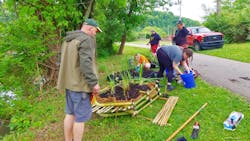Floating wetlands launched at University of Tennessee
KNOXVILLE, Tenn. – A unique solution meets both environmental and instructional needs for students at the University of Tennessee. Green Infrastructure, a class offered by the UT Department of Plant Sciences in the sustainable landscape design concentration, has introduced floating wetlands to the Third Creek ecosystem as part of a capstone project.
Taught by Mike Ross, assistant professor in the Herbert College of Agriculture and College of Architecture and Design School of Landscape Architecture, the class empowers students tackling looming environmental challenges with accessible, imaginative and sustainable solutions.
“In the course, students study ecological design interventions, especially locally, such as bioswales on campus, a system that filters stormwater runoff. By utilizing regenerative systems and nature’s own resilience, I hope to empower students,” says Ross.
The floating wetlands introduced at Third Creek are micro island habitats for plants and wildlife made with bamboo harvested from campus. The islands are secured to the bank of Third Creek. The project addresses the lack of riparian buffer, or vegetative areas between hardscapes and waterways. The wetlands’ flora also clean contaminates from the stream in a process known as phytoremediation.
Andrea Ludwig, associate professor and Extension specialist in the Department of Biosystems Engineering and Soil Science, consults for Green Infrastructure. “We chose native perennials for the wetlands that can be used again and divided as they grow,” Ludwig explains further benefits of the project. “I see plants move and find their niche, where they thrive. Students do not have to get it completely right. If we get close, nature will do the rest.”
The Herbert College of Agriculture regularly takes advantage of interdisciplinary collaboration. Ludwig speaks to her unique perspective working with design students as an engineer and Extension specialist, “Traditionally, my field has focused more on functionality. Now, it is vital to think about how designed ecosystems are being utilized in the landscape and affect the community as a whole. Because we have made space to bring everyone’s strengths and ideas to the table, Mike and I learn from each other and the students. I see students and especially young people as key stakeholders of UT Extension.”
Ross’s pedagogical approach is indeed collaborative. Moreover, the hands-on curriculum underscores access, diversity and personal responsibility. “There are more high-tech, expensive and larger approaches. However, students are learning about grassroots, ground-up techniques mitigating adverse environmental situations, particularly in public spaces, which emphasize the power of individuals and communities, especially those in economically challenged areas.”
Mia Roark, a graduate student in landscape architecture, is the first Third Creek intern hired by the Department of Plant Sciences as part of a larger project to restore the area. “My role is to bring together multiple disciplines, connect current efforts and push further. From ecological restoration to conservation to large-scale and future planning, my goal is to help improve the space and educate the public on our collective efforts,” Roark explains.
Roark also trusts that everyday citizens have the power to affect change. “Interact and support local spaces you enjoy and are able to access. Examine what is needed and figure out how you can help. As the natural environment thrives at Third Creek despite pressures, it is proof that even in anthropogenically stressed environments, the landscape persists. There are still plenty of native plants and animals, and I believe our efforts will increase biodiversity and foster the life that is there,” Roark hopes.
With the focus on areas like Third Creek, Ross and Ludwig are leading a larger initiative to create an exemplary urban environment across the university campus. “Here, we have spaces that reflect power and influence designed to impress potential students, parents and donors. However, there are significant efforts with colleagues across departments, including faculty, staff and students, and namely Facilities Services, to enhance ecological landscapes, increase biodiversity and provide outdoor spaces for a range of local stakeholders.”
“While the floating wetlands were being launched, students noticed a turtle hatchling on the bank. It gives me hope that there is a thriving, resilient ecosystem, even in an area like Third Creek, where visible garbage floats” Ross says ”I also have hope that students and citizens alike will use their agency to improve where they live. This is our drinking water. Do we, one day, want to fish in the Tennessee River? Do we want to wade in Third Creek? These are not insurmountable goals,” Ross finishes.


